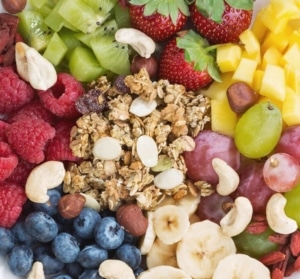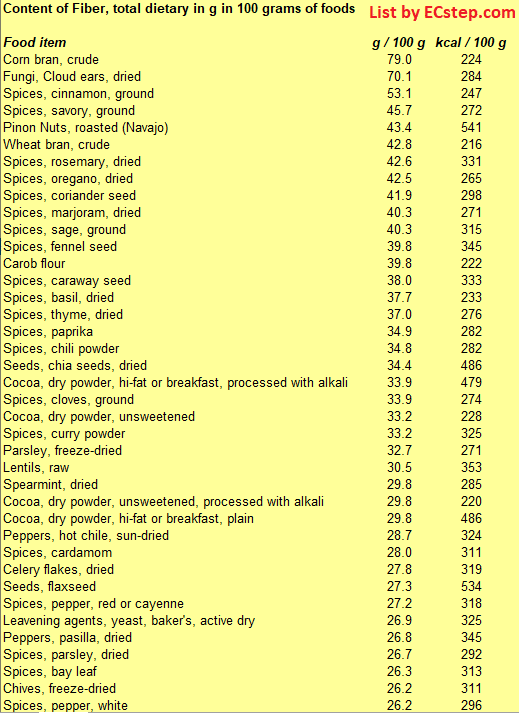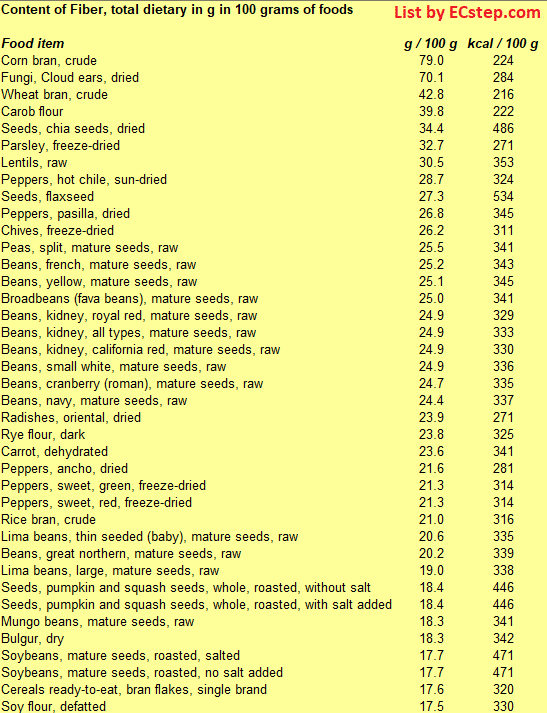Dietary fiber
Dietary fiber or roughage is the portion of plant-derived food that cannot be completely broken down by digestive enzymes. It has two main components:
Soluble fiber – which dissolves in water – is readily fermented in the colon into gases and physiologically active by-products, such as short-chain fatty acids produced in the colon by gut bacteria; it is viscous, may be called prebiotic fiber, and delays gastric emptying which, in humans, can result in an extended feeling of fullness.
Insoluble fiber – which does not dissolve in water – is inert to digestive enzymes in the upper gastrointestinal tract and provides bulk. Some forms of insoluble fiber, such as resistant starches, can be fermented in the colon. Bulking fibers absorb water as they move through the digestive system, easing defecation.
 Dietary fiber consists of non-starch polysaccharides and other plant components such as cellulose, resistant starch, resistant dextrins, inulin, lignins, chitins, pectins, beta-glucans, and oligosaccharides.
Dietary fiber consists of non-starch polysaccharides and other plant components such as cellulose, resistant starch, resistant dextrins, inulin, lignins, chitins, pectins, beta-glucans, and oligosaccharides.
Dietary fibers can act by changing the nature of the contents of the gastrointestinal tract and by changing how other nutrients and chemicals are absorbed.
Some types of soluble fiber absorb water to become a gelatinous, viscous substance that may or may not be fermented by bacteria in the digestive tract.
Some types of insoluble fiber have bulking action and are not fermented.
Lignin, a major dietary insoluble fiber source, may alter the rate and metabolism of soluble fibers.
Other types of insoluble fiber, notably resistant starch, are fermented to produce short-chain fatty acids (SCFAs), which are physiologically active and confer health benefits.
Food sources of dietary fiber have traditionally been divided according to whether they provide soluble or insoluble fiber.
Plant foods contain both types of fiber in varying amounts, according to the plant’s characteristics of viscosity and fermentability.
The advantages of consuming fiber depend upon which type of fiber is consumed and which benefits may result in the gastrointestinal system.
Bulking fibers – such as cellulose, hemicellulose, and psyllium – absorb and hold water, promoting regularity.
Viscous fibers – such as beta-glucan and psyllium – thicken the fecal mass.
Fermentable fibers – such as resistant starch and inulin – feed the bacteria and microbiota of the large intestine, and are metabolized to yield short-chain fatty acids, which have diverse roles in gastrointestinal health.
Dietary fiber is found in plants, typically eaten whole, raw, or cooked, although fiber can be added to make dietary supplements and fiber-rich processed foods.
Grain bran products have the highest fiber contents, such as crude corn bran (79 g per 100 g) and crude wheat bran (43 g per 100 g), which are ingredients for manufactured foods.
Medical authorities, such as the Mayo Clinic, recommend adding fiber-rich products to the Standard American Diet (SAD) which is rich in processed and artificially sweetened foods, with minimal intake of vegetables and legumes.
Sources of fiber
Some plants contain significant amounts of soluble and insoluble fiber. For example, plums and prunes have thick skin covering a juicy pulp. The skin is a source of insoluble fiber, whereas soluble fiber is in the pulp. Grapes also contain a fair amount of fiber.
Soluble fiber is found in varying quantities in all plant foods, including:
- legumes (peas, soybeans, lupins, and other beans)
- oats, rye, chia, and barley
- some fruits (including figs, avocados, plums, prunes, berries, ripe bananas, and the skin of apples, quinces, and pears)
- certain vegetables such as broccoli, carrots, and Jerusalem artichokes
- root tubers and root vegetables such as sweet potatoes and onions (skins of these are sources of insoluble fiber also)
- psyllium seed husks (a mucilage soluble fiber) and flax seeds
- nuts, with almonds being the highest in dietary fiber
Sources of insoluble fiber include:
- whole-grain foods
- wheat and corn bran
- legumes such as beans and peas
- nuts and seeds
- potato skins
- lignans
- vegetables such as green beans, cauliflower, zucchini (courgette), celery, and nopal
- some fruits including avocado, and unripe bananas
- the skins of some fruits, including kiwifruit, grapes, and tomatoes
Foods with the highest content of dietary fibers
In the table below the food items with the highest content of dietary fibers in all food groups are presented. Commercial brand products are not included. The list is made using ECstep’s Personal Nutrition Data Program.

In the table below the food items with the highest content of dietary fibers in vegetables, legumes, fruits, nuts and seeds, and grains are presented. Commercial brand products are not included. The list is made using ECstep’s Personal Nutrition Data Program.
.

Fiber supplements
Soluble fiber supplements may be beneficial for alleviating symptoms of irritable bowel syndrome, such as diarrhea or constipation and abdominal discomfort.
Prebiotic soluble fiber products, like those containing inulin or oligosaccharides, may contribute to relief from inflammatory bowel disease, as in Crohn’s disease, ulcerative colitis, and Clostridium difficile, due in part to the short-chain fatty acids produced with subsequent anti-inflammatory actions upon the bowel.
Fiber supplements may be effective in an overall dietary plan for managing irritable bowel syndrome by modification of food choices.
One insoluble fiber, resistant starch from high-amylose corn, has been used as a supplement and may contribute to improving insulin sensitivity and glycemic management as well as promoting regularity and possibly relief of diarrhea.
One preliminary finding indicates that resistant corn starch may reduce symptoms of ulcerative colitis.
Activity in the gut
Many molecules that are considered to be “dietary fiber” are so because humans lack the necessary enzymes to split the glycosidic bond and they reach the large intestine.
Dietary fibers make three primary contributions: bulking, viscosity and fermentation.
Different fibers have different effects, suggesting that a variety of dietary fibers contribute to overall health. Some fibers contribute through one primary mechanism.
Cellulose and wheat bran provide excellent bulking effects but are minimally fermented. Psyllium provides bulking as well as viscosity.
Bulking fibers can be soluble (i.e., psyllium) or insoluble (i.e., cellulose and hemicellulose). They absorb water and can significantly increase stool weight and regularity. Most bulking fibers are not fermented or are minimally fermented throughout the intestinal tract.
Viscous fibers thicken the contents of the intestinal tract and may attenuate the absorption of sugar (good if you are a diabetic), and reduce cholesterol absorption.
Not yet formally proposed as an essential macronutrient, dietary fiber has importance in the diet, with regulatory authorities in many developed countries recommending increases in fiber intake.
Adding viscous polysaccharides to carbohydrate meals can reduce post-prandial blood glucose concentrations. Wheat and maize but not oats modify glucose absorption, the rate being dependent upon the particle size.
Dietary fiber interacts with pancreatic and enteric enzymes and their substrates. Human pancreatic enzyme activity is reduced when incubated with most fiber sources. Fiber may affect amylase activity and hence the rate of hydrolysis of starch. The more viscous polysaccharides extend the mouth-to-cecum transit time.
Fibers in the colon
The right side (cecum and ascending colon) is a fermenter as it is involved in nutrient salvage so that dietary fiber, resistant starch, fat, and protein are utilized by bacteria and the end-products can be absorbed for use by the body.
The left side (transverse, descending, and sigmoid colon) affects continence.
In the colon, the dietary fibers may be fermented by bacteria, which increase in numbers and activity. Water and electrolytes are also absorbed in the colon to minimize the loss of these important components.
Enlargement of the cecum is a common finding when some dietary fibers are fed and this is believed to be a normal physiological adjustment.


